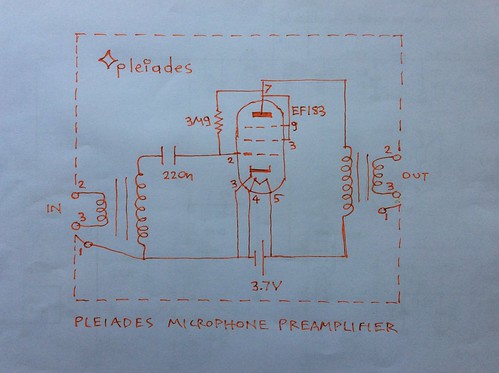A way to operate electron tubes (vacuum tubes, or electronic valves) at very low plate (anode) voltage or potential is a pull up grid resistor.
Low plate voltage, underheating at cathode does not mean more distortion or noise. The contrary is possible especially on noise due to decrease in secondary emission noise, positive ions, thermal or photoelectric emission of electrons from other electrons than the cathode. The electron tube is still linear but it can handle smaller input signals or more readily process or peak limit larger ones with the fewest amplification stages possible for an increased subjective loudness [Hamm].
Why is a bias resitor from a positive potential to grid required? Will it not cause the grid bias to become positive?
No, not nessesarily. When we normally apply the heater voltage to increase the temperature of the cathode, the emmited electrons cause the electric potential of the grid to become so negative (typically -700mV) that anode current is practically cutoff for low anode supply potentials. The pull up resitor will bring the grid to a less negative bias (typically -70mV) allowing anode current and linear operation of the electron tube. [The Pleiades bias]
This post does not claim to be a historical reference. Some of the important dates on the subject are listed below:
1913
Langmuir patents space charge tetrodes. The grid is connected to a positive supply. The signal is applied to the screen grid. Anode voltage can be low for high anode current.
1914
Edwin Armstrong inserts a free grid (unconnected grid) between cathode and anode of a vacuum electron tube and observes a reduction in anode, plate or wing as it was called current.
1930
F. B. Llewellyn points out that a lower cathode temperature can be used with a lower anode potential. Space charge conditions still apply and shot noise is still thereby nonexistent. He also showed that the thermal noise temperature of the anode internal output resistance is at the cathode temperature.
1934
J. R. Dunning points out to G. L. Pearson, for a specific electron tube, lower noise floating grid operation at equilibrium potential at lower cathode temperature and with lower screen and plate voltages.
1947
Georg Neumann produces the Neumann U47 microphone possibly the most successful studio microphone with its head amplifier VF14 electron tube operated at substantially lower anode and heater voltage than the VF14 datasheet specifications.
1952
Philip Clark accidentally discovers operation with no plate supply when a pull up resistor is connected to the control grid. Cathode, the more positive self biased electrode due to electron emission is the anode voltage supply itself. It is strange that the figures show battery bias in pull down direction (misprint?) and power supply bias in pull up direction.
1957
C. E. Atkins (Tung-Sol Electric inc) introduces redesigned space charge tetrodes such as 12K5 able to give power even at 12V plate supply.
1959 RCA announces the Nuvistor electron tubes capable of operating at low anode electric potential with high transconductance, small size, military or space reliability and low heater current.
1991
Brent K. Butler receives US5022305 patent on a tube overdrive pedal with greater headroom and gradual distortion range. This is achieved by a pull up resitor from 9V to the anode of the 12AX7a compared to headroom with a conventional grid to cathode resistor. Heaters and anode are supplied by 9V.
Pleiades electron tube amplifiers are developed capable of operation with one battery supplying normally lower than spec heater voltage and very low anode voltage. The V1 microphone booster amplifier operating with an AAA 1.2V battery and the electrometer tube CV2269 in a small 2.5x3 inch x inch box.
The Pleiades Electra II headphone amplifier with one space charge underheated 12K5 tetrode per channel and no other active or passive component. 9 volt operation for both heaters and anode.
Other V series low noise microphone booster amplifiers operating with conventional electron tubes: The Pleiades V2, V3, V4, V5 or V6 with electron tubes such as 12AU7 with 6V to 4V. The EF183 variμ pentode triode connected or the Nuvistor 7586 operated with 3.9V for heaters and the anode from 3.9V to 500mV. The 2DS4 operating with an AA 1.2V battery for both heater and anode supply. Pull up or Pleiades bias resistor is normally connected from anode to grid as it was found by microphone amplification listening tests to produce an even more natural sound. The reason is not known, possibly negative feedback?.
If you know more about the history please post references.
Aknowledgments to Jeff Duntemann for his article on tubes running on 12V on the plates. To Hliana Stalika for pointing out the importance of pull up biasing for liberating the electrons. To Stephen Keller and to Merlin Blencowe for many important references and information on Merlin Blencowe's article Triodes at low voltage. To Emilio Ciardiello and parts-ring.com for the Philip B. Clark no plate supply reference. To Sean Davies for pointing out his successful use of electrometer electron tubes for condenser microphone head amplifiers.
References:
Tubes vs Transistors (vs op amps), is there an audible difference? - Russel O. Hamm - JAES
Operating features of the Audion - E. H. Armstrong
A study of Noise in Vacuum tube and attached circuits - F. B. Llewellyn - PRoc.IRE vol8 no2 Feb 1930
Fluctuation Noise in Vacuum Tubes - G. L. Pearson - Bell Telephone Laboratories - Physics Vol 5 Sept 1934
Neumann U47 report - BBC research department
http://downloads.bbc.co.uk/rd/pubs/reports/1954-23.pdf
Vacuum-tube circuits without plate supplies - Philip B. Clark - Electronics December 1952
https://www.americanradiohistory.com/Archive-Electronics/50s/Electronics-1952-12.pdf
Low Plate-potential tubes - Radio and Television News - January 1957
http://www.rfcafe.com/references/radio-news/low-plate-potential-tubes-january-1957-radio-television-news.htm
https://en.m.wikipedia.org/wiki/Nuvistor
Tube overdrive pedal operable using low voltage DC battery eliminator - Brent K. Batler - US5022305 Patent
https://worldwide.espacenet.com/searchResults?submitted=true&locale=en_EP&DB=EPODOC&ST=advanced&TI=&AB=&PN=US5022305&AP=&PR=&PD=&PA=&IN=&CPC=&IC=&Submit=Search
The Pleiades V1 operating with just an AAA battery - euroelectron
Pleiades Electra schematics - euroelectron
http://euroelectron.blogspot.com/2014/07/pleiades-electra-schematics.html
Pleiades V6 schematic - euroelectron
http://euroelectron.blogspot.com/2017/07/pleiades-v6-schematic.html

http://www.junkbox.com/electronics/lowvoltagetubes.shtml
The Pleiades Bias - euroelectron














